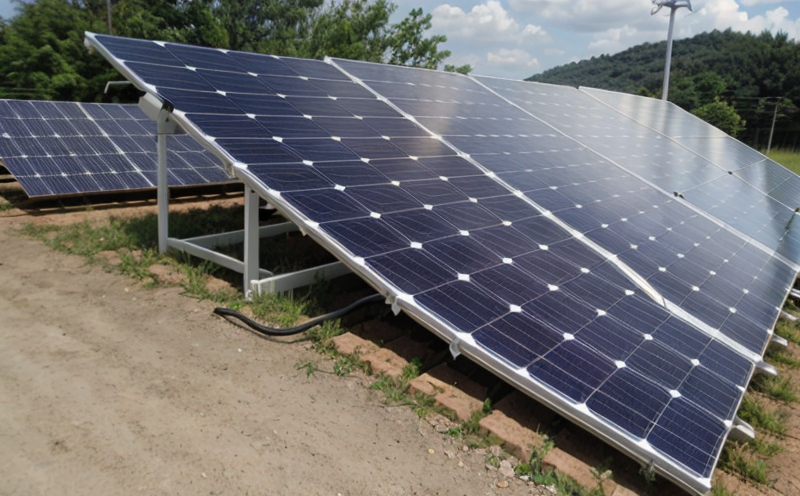IEC 61215-2 Wet Leakage Current Testing
In the realm of photovoltaic (PV) module testing within the broader context of renewable energy, ensuring product safety and performance is paramount. IEC 61215-2 standards provide a critical framework for evaluating solar panels and photovoltaic modules under various environmental conditions, including wet leakage current testing. This section delves into the intricacies of this test, its scope, methodology, competitive advantages, market impact, real-world applications, and frequently asked questions.
The IEC 61215 series is a set of international standards that specify requirements for performance, safety, and environmental conditions applicable to photovoltaic (PV) modules. These standards are crucial in ensuring the quality and reliability of solar PV systems. The second part of this standard, IEC 61215-2, focuses on testing methods used during production acceptance tests.
One key aspect of these tests is wet leakage current measurement, which assesses how a module behaves when exposed to water. This test ensures that the solar panel does not allow excessive current flow in wet conditions, thereby reducing the risk of electrical shock and fire hazards. The testing procedure involves simulating real-world scenarios where PV modules might be exposed to moisture.
The IEC 61215-2 standard outlines specific procedures for determining the leakage current under both direct and alternating currents (DC/AC). This includes detailed instructions on specimen preparation, equipment setup, measurement techniques, and acceptance criteria. Compliance with these standards ensures that manufacturers produce high-quality PV modules that meet global safety regulations.
Compliance with IEC 61215-2 is mandatory for all solar panel manufacturers aiming to sell their products in international markets. The rigorous testing process helps build consumer trust by ensuring consistent product quality across different environments and climates worldwide.
Scope and Methodology
The IEC 61215-2 wet leakage current test aims to evaluate the performance of PV modules under controlled environmental conditions that mimic real-world exposure. The primary goal is to ensure that these modules can withstand potential risks associated with electrical contact in damp environments without compromising safety or functionality.
- Environmental Setup: Specimens are placed in a chamber designed to replicate typical weather conditions, including humidity and temperature variations.
- Test Conducted: Leakage current measurements are taken while applying direct and alternating currents across the module's terminals. This helps identify any defects or insulation weaknesses.
- Data Analysis: Results from these tests are analyzed to determine whether the module meets specified limits for leakage current, which vary based on the type of PV technology used (mono-crystalline, poly-crystalline).
The test results play a crucial role in determining the reliability and safety of solar panels throughout their lifecycle. By adhering strictly to IEC 61215-2 guidelines, manufacturers demonstrate their commitment to producing safe and efficient PV modules.
Competitive Advantage and Market Impact
Adopting IEC 61215-2 wet leakage current testing offers several competitive advantages for solar panel manufacturers. Firstly, it enhances brand reputation by ensuring consistent product quality across all production batches. Secondly, compliance with these international standards opens up new market opportunities in countries that require stringent safety certifications.
- Enhanced Brand Reputation: Consistent performance and reliability build trust among consumers and industry stakeholders.
- New Market Opportunities: Meeting global regulatory requirements increases access to international markets, particularly those with high safety standards.
In addition to these benefits, organizations that integrate IEC 61215-2 into their quality assurance processes also see reduced liability risks and improved customer satisfaction. These factors contribute significantly to the overall success of a company within the competitive renewable energy sector.
The market impact of adhering to such stringent testing protocols cannot be overstated. As awareness grows about climate change impacts, there is increasing demand for sustainable energy solutions like solar power. Companies that prioritize safety and quality through rigorous testing will continue to lead in this rapidly expanding field.
Use Cases and Application Examples
The IEC 61215-2 wet leakage current test finds application in various scenarios where PV modules might encounter water exposure during installation or operation. These include:
- Rooftop Solar Installations: Modules may come into contact with rainwater, snowmelt, or condensation.
- Offshore Wind Farms: While primarily focused on wind energy, these farms often incorporate solar power systems for additional electricity generation. PV modules here must withstand salt spray and heavy rainfall.
- Agricultural Greenhouses: Solar panels installed in greenhouses need to function reliably even after frequent irrigation activities.
In all these cases, the ability of a module to safely handle water exposure is critical for preventing failures that could lead to significant downtime or safety hazards. By incorporating IEC 61215-2 compliant testing into their quality control processes, manufacturers can ensure that their products perform consistently across diverse applications.





